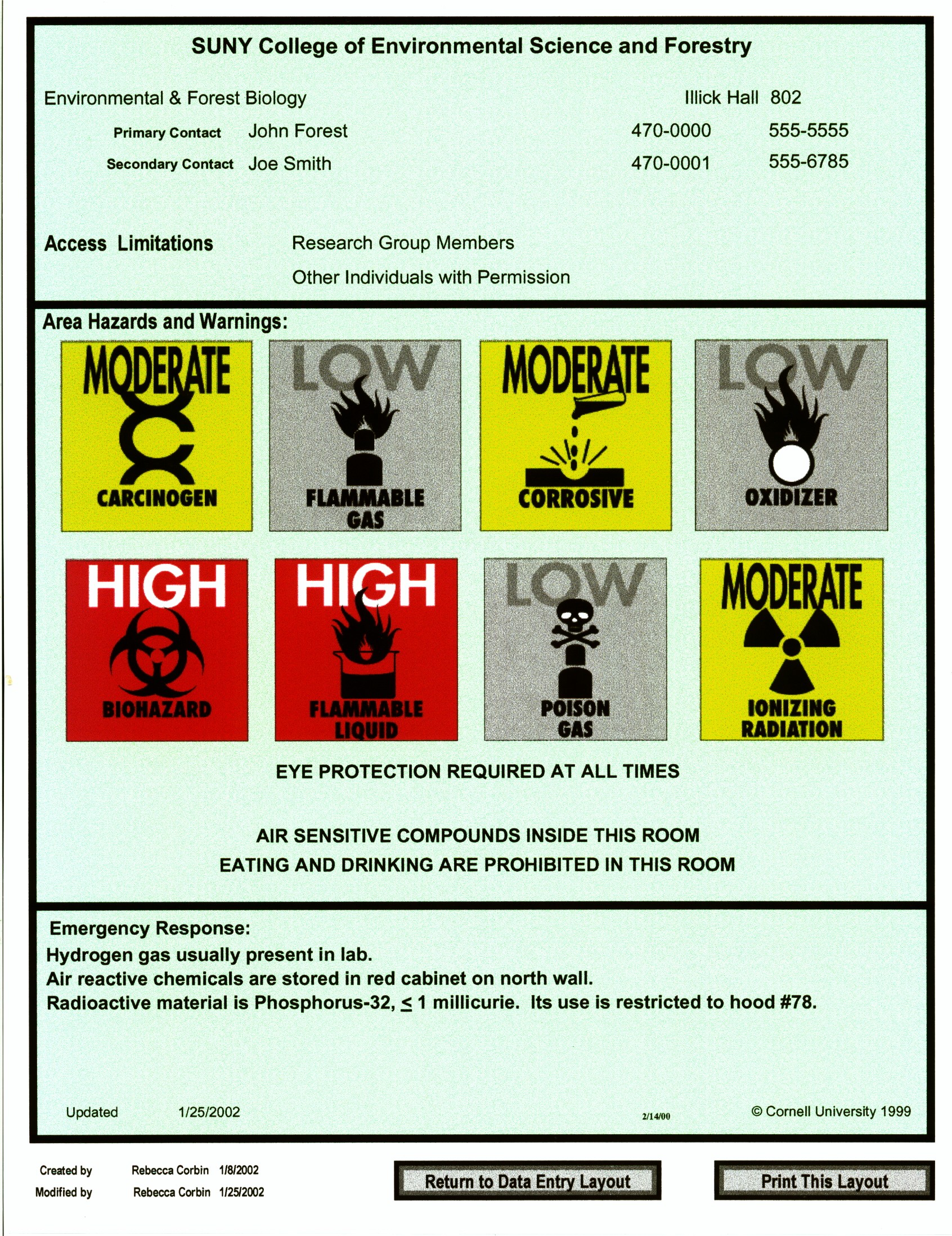Environmental Health and Safety Services
Hazard Assessment Signage Program Instructions
The Hazard Assessment Signage Program (HASP), designed by Cornell University, creates laboratory entrance signs that provide important information regarding emergency contact, warnings, and assessment of hazards contained within the lab. The signs can be customized to reflect the particular hazards and situations of individual labs. A sample sign is available below for your reference.
Use these instructions to help you complete the HASP Data Entry Form and submit the completed form to the Environmental Health and Safety Office. A sign will then be created for your lab, with a copy kept on the EHS database. The sign can be updated at any time as personnel or circumstances change. Please take the time to provide accurate and useful information.
1. The HASP Data Entry Form should be submitted electronically (online version) or printed out, filled in, and mailed it to the EHS Office, 19 Bray Hall.
2. Complete each of the sections as described below:
Department: Enter the department to which the lab belongs (ex. Chemical Engineering)
Building: Enter building name
Room No: Enter room number
Primary Contact: Enter the name of the individual who is most informed about lab processes and activities. This is the individual who will be contacted in case of emergency. Also enter the daytime, and if desired, the night time phone number for this person.
Secondary Contact: Enter the name of a second individual who may be contacted in the event of an emergency. The department chair should be listed if a more appropriate person is not available. Also enter the daytime, and if desired, the nighttime phone number for this person.
Access notice 1 and Access notice 2: Enter either one or two phrases related to the lab’s access restrictions. You may phrase this to best describe your situation, but some examples are:
- Research Group Members
- Faculty, Staff and Students
- Individuals with Permission of Investigator
- Other Individuals with Permission
Hazards #1 - #8: You may list up to eight physical and chemical hazards present in the lab. (Ex. Biohazard, Flammable Gas) Choose any applicable hazards, and a corresponding hazard risk level of ?low?, ?moderate?, or ?high? from the Hazard Definition Sheet, linked below. The sheet defines each possible hazard and describes how to choose the appropriate risk level.
Warnings 1 – 4: Enter up to four textual restrictions or further hazard descriptions. You may phrase this to best describe your situation, but some examples are:
- Eye protection required at all times
- Eye protection required when working with chemicals or when
mechanical danger exists - Door must be kept locked at all times
- Eating and drinking are prohibited in this lab
- Eating and drinking are allowed in designated areas only
Warnings and Suggestions to an Emergency Responder: Enter any information that may be useful in an emergency response situation. Examples of this type of information are:
- Hydrogen gas is usually present in lab (always note this, when applicable)
- Water reactive chemicals are stored in yellow cabinet on north wall
- Large amounts of extremely flammable liquids are used in this lab
- Emergency power shut off is located on the wall to the left of doorway
3. If you have any questions, contact the EHS Office at 470-6964.
- Sample Sign

- HASP Data Entry Form
- Online Version—Complete and submit online
- PDF Version - Print and mail
- Hazard Definition Sheet
